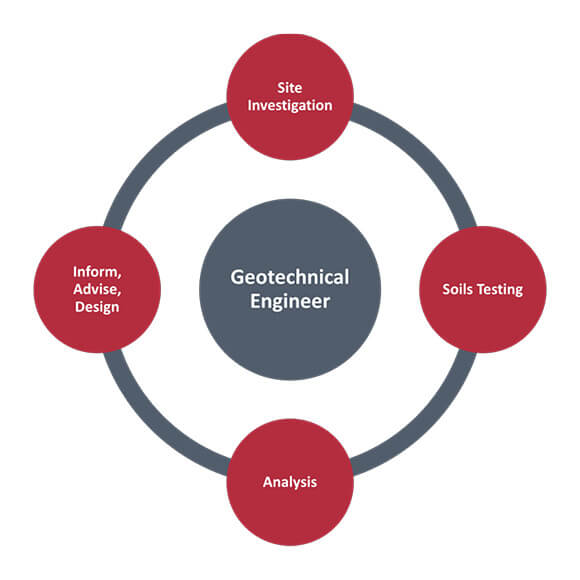Getting The Geotheta To Work
Getting The Geotheta To Work
Blog Article
Not known Factual Statements About Geotheta
Table of ContentsThe Best Strategy To Use For GeothetaGeotheta Can Be Fun For EveryoneExcitement About GeothetaGeotheta Fundamentals Explained
They collaborate with civil engineers, structural engineers, designers, and various other experts to integrate geotechnical factors to consider into the general job design and building and construction process. This needs efficient synergy, coordination, and interaction to ensure that the geotechnical aspects align with the job objectives and meet governing needs.Mining & Products Design: Concepts of boring, penetration prices, and elements impacting the selection of exploration approach. Blasting strategies in surface area and underground operations. Mechanical and continual techniques to fragmentation, including longwall shearing and fullface boring.
Modelling of fragment and particle size circulations; comminution as a transfer feature. Comminution modern technology: squashing, grinding, size classification. Integrated evaluation of fragmentation and comminution procedures. Supplied by: Mining & Products Engineering.
9 Simple Techniques For Geotheta
Bachelor's degree programs in civil, geotechnical, geological, and ecological engineering typically last four years and include basic education programs in English, social scientific research, and the humanities, in addition to training courses in sophisticated mathematics, architectural geology, and fluid mineralogy. (https://ameblo.jp/geotheta/entry-12862281966.html)
Geotechnical design involves the analysis of the dirt and rock conditions at a particular website, and their implications for the advancement of that website. As the majority of structures rely upon the ground for assistance, it is without surprise that a thorough understanding of the ground conditions, and the viability of structure systems, are crucial to the long-term security and performance of the structure or structure.
Being experts in the investigation of geological formations and ground behaviour, geotechnical designers do clinical examinations and testing to recognize the influence these geological formations might have on the style and building and construction of structure, civil and infrastructure tasks. This proficiency is critical for the style and construction of structures, roads, passages, dams, bridges, and water supply and sewage systems.
The geotechnical team at Douglas Allies consistently seek advice from engineers, style engineers, developers, and contractors to make recommendations on layout and growth proposals to make sure that the constructed frameworks are appropriately made for the ground conditions. For instance, the layout of footing systems requires to take into consideration the weight of the structure, the ability of the ground to sustain that weight together with movement resistances and efficient building.
The Ultimate Guide To Geotheta
This job is greatly simplified by the use of our Douglas Map geospatial system that makes this info conveniently easily accessible in an easy to utilize internet browser user interface. A geotechnical engineer will direct the boring of boreholes and test pits to accumulate soil and various other samples, and likewise evaluate surface area attributes and ground exposures to form a geotechnical version of the subsurface conditions.
Depending on the job kind and ground problems experienced, laboratory screening may to name a few points examine toughness, compressibility, reactivity and/or permeability of soil and rock examples. After this information is collected and looked at, the outcomes are utilized for a geotechnical version of the site, which is normally provided as sections throughout the site.

A geotechnical examination naturally can only examine the ground problems at the locations drilled or excavated. Natural variants in dirt and rock problems can take place throughout a website and between test locations. It is for that reason great practice that the geotechnical engineer be maintained throughout construction of the job to provide on-site verification that the ground problems run into are regular with the expectations and recommendations offered in the geotechnical investigation record.
See This Report on Geotheta
Geotechnical designers utilize their extensive expertise of dirt and rock to analyze risk and solve issues on varied framework projectsGeotechnical design is a specialist branch of civil design which considers the practices of earth materials and the application of soil and rock auto mechanics. Consulting Engineers. As a geotechnical designer, you will assess the physical, mechanical and chemical buildings of dirt and rock in order to develop structures, maintaining frameworks and earthworks
Geotechnical design is carefully connected to and overlaps with, both design geology and ground engineering - https://giphy.com/channel/geotheta. It's feasible to specialise in geotechnics or benefit a geotechnical business but be understood as an engineering geologist or a ground designer. As a geotechnical designer, you'll need to: construct and maintain connections with customers and various other professionals associated with the site, throughout each projectmaintain security standards on website be conscious of cost effects when you make recommendationsstudy geological maps and airborne photographs from a variety of sources and from various time periodsexamine building and construction prepares to see how practical they are based on your understanding of the siteinvestigate threats or geological dangers for the sitesearch for environmentally delicate attributes, such as landfill begin to establish accurate and expository ground modelsplan field investigationsdrill and analyse examples of bedrock, dirt, groundwater and added materials supervise other specialists on sitesolve technological problems as they occur, such as unforeseen frameworks at drill sitesmonitor conditions during and after building and construction to make sure structures are secure in the brief and lengthy termadding information collected on website to your preliminary researchcreating geotechnical estimations, illustrations, and 2 or three-dimensional computer models translating web the datamaking referrals concerning the suggested usage of the site

Report this page